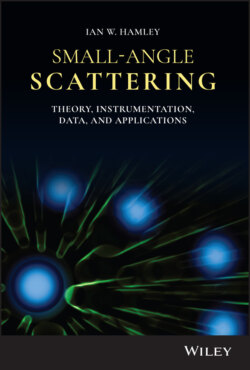Читать книгу Small-Angle Scattering - Ian W. Hamley - Страница 13
1.3 INTENSITY FOR ANISOTROPIC AND ISOTROPIC SYSTEMS AND RELATIONSHIPS TO PAIR DISTANCE DISTRIBUTION AND AUTOCORRELATION FUNCTIONS 1.3.1 General (Anisotropic) Scattering
ОглавлениеIn the following, notation to indicate that the intensity is ensemble or time‐averaged is not included for convenience (if the system is ergodic, which is often the case apart from certain gels and glasses etc., these two averages are equivalent).
The intensity is defined as
(1.4)
Thus, using Eq. (1.2), for an ensemble of discrete scattering centres
(1.5)
Whereas, for a continuous distribution of scattering density,
(1.6)
Equation (1.6) can also be rewritten in terms of an autocorrelation function (sometimes known as convolution square function) writing r ′ − r ″ = r
(1.7)
Then
(1.8)
The autocorrelation function has the physical meaning of the overlap between a particle and its ‘ghost particle’ displaced by r (Figure 1.2). This function is the continuous version of the Patterson function familiar from crystallography.
Figure 1.2 Ghost particle construction. The overlap volume (shaded) is the autocorrelation function.
The autocorrelation function for solid geometrical bodies can be calculated analytically. For a sphere of radius R the expression is isotropic and is given by [5–7]
(1.9)
This is a smoothly decaying function of r. The expression for a cylinder is provided in Ref. [8] and can be calculated for other structures, asymptotic expressions for cylinders and discs are given in Eqs. (1.83) and (1.84).
Equation (1.6) can alternatively be written for uncorrelated scatterers as
(1.10)
